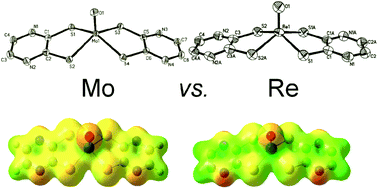Comparison of molybdenum and rhenium oxo bis-pyrazine-dithiolene complexes – in search of an alternative metal centre for molybdenum cofactor models†
Abstract
A pair of structurally precise analogues of molybdenum and rhenium complexes, [Et4N]/K2[MoO(prdt)2] and K[ReO(prdt)2] (prdt = pyrazine-2,3-dithiolene), were synthesized. These complexes serve as structural models for the active sites of bacterial molybdenum cofactor containing enzymes. They were comprehensively characterized and investigated by NMR, computationally supported IR and resonance Raman spectroscopy, cyclic voltammetry, mass spectrometry, elemental analysis and single-crystal X-ray diffraction. All compiled data are discussed in the context of comparing chemical and electronic structures and consequences thereof. This study constitutes the first investigation of a potential alternative Moco model system bearing rhenium as the central metal in an identical coordination environment to its molybdenum analogue. Structural evaluation revealed a slightly stronger M![[double bond, length as m-dash]](https://www.rsc.org/images/entities/char_e001.gif) O bond in the rhenium complex in accordance with spectroscopic results, i.e. observed bond strengths. Thermodynamic parameters for the redox processes MoIV ↔ MoV and ReIV ↔ ReV were obtained by temperature dependent cyclic voltammetry. In contrast to molybdenum, rhenium loses entropy upon reduction and its redox potential is more temperature sensitive, indicating more significant differences than the respective diagonal relationship between the two metals in the periodic table might suggest and questioning rhenium's suitability as a functional artificial active site metal.
O bond in the rhenium complex in accordance with spectroscopic results, i.e. observed bond strengths. Thermodynamic parameters for the redox processes MoIV ↔ MoV and ReIV ↔ ReV were obtained by temperature dependent cyclic voltammetry. In contrast to molybdenum, rhenium loses entropy upon reduction and its redox potential is more temperature sensitive, indicating more significant differences than the respective diagonal relationship between the two metals in the periodic table might suggest and questioning rhenium's suitability as a functional artificial active site metal.



 Please wait while we load your content...
Please wait while we load your content...